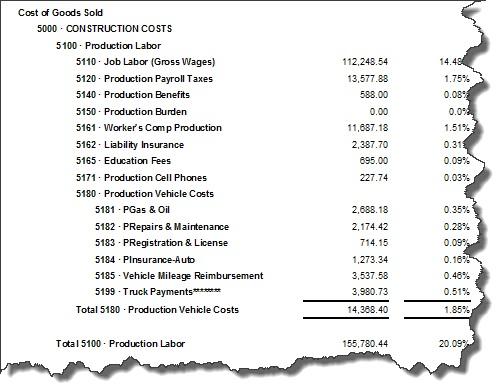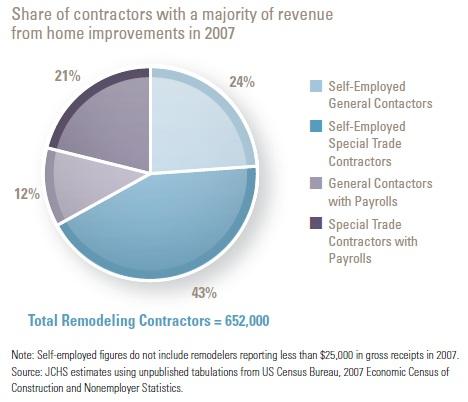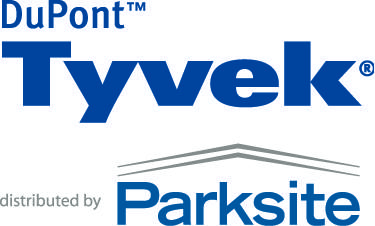Five Keys To Getting Contractor Financial Reports That Speak To You

Guest Blogger: Melanie Hodgdon is a Certified QuickBooks ProAdvisor who has been providing financial analysis and QuickBooks training for contractors since 1994. She’s the co-author of A Simple Guide to Turning a Profit as a Contractor. Melanie and Shawn often coordinate their efforts when helping remodelers develop financial systems for their businesses so they serve the contractor, not just their accountant.
“How can I get meaningful financial reports for my construction business?”

There’s a big difference between a pile of materials and a well-designed building. Yes, everything required to create and use the building is contained within the pile, but until it’s been put together with the intention of producing something useful and well-thought-out, it’s pretty much useless.
The same thing applies to contractor financial reports
I have worked with literally hundreds of contractors’ financial databases, and many of them have got the majority of the information in there, all right. The problem is that, just like the pile of materials, the information isn’t organized in a way to let them easily draw conclusions. Just like the point of having a house is to provide shelter, the point of having financial reports is to make informed management decisions.
My clients, seminar attendees, and reader audience are probably sick of hearing this, but if reports don’t provide useful information at-a-glance, they aren’t doing you any good. Contractors can’t afford to have their bookkeeper or accountant adjust, explain, and interpret reports. Waiting for this kind of information puts them at the mercy of others. Instead, any contractor should be able to instantly access, review, and draw conclusions from standard reports any time he feels like it!
Begin with the end in mind
 The key to getting this right and meaningful is to decide beforehand what questions you want answered. So if you want to know what your gross profit is, for example, then you need to set up your Chart of Accounts to show it to you. If you want to figure out how much your production workers are costing you, then be sure to capture all the burdens along with the wages. If you want to find out which marketing methods are working best, then you’ll need to have two categories of information: (1) you’ll have to have your financials set up so you can see costs by marketing source, and (2) you’ll have to have a lead tracking system that will identify which leads are coming in from which source.
The key to getting this right and meaningful is to decide beforehand what questions you want answered. So if you want to know what your gross profit is, for example, then you need to set up your Chart of Accounts to show it to you. If you want to figure out how much your production workers are costing you, then be sure to capture all the burdens along with the wages. If you want to find out which marketing methods are working best, then you’ll need to have two categories of information: (1) you’ll have to have your financials set up so you can see costs by marketing source, and (2) you’ll have to have a lead tracking system that will identify which leads are coming in from which source.
Even software that advertises itself as being set up specifically for contractors doesn’t necessarily classify costs in the most useful way for a particular company; relying on the software to control the content and level of detail of information means you may be giving up answers that are important to you.
Here are five keys to getting the financial reports contractors need:
- First and foremost, give accounts names that make sense to you. If you want to call your refuse disposal garbage, do it. Don’t be hung up on what your accountant thinks it should be called. Use names that are familiar, descriptive, and have meaning for you.
- Separate costs related to production from overhead by using different types of accounts; when you run your financial reports, they will be in different regions of the reports and you should be able to get key numbers (such as gross profit) without doing anything more.
- Use account numbers to control the order of the accounts. Without numbers, your reports may appear in alphabetical order, which may be far less revealing.
- Organize the accounts in clusters; use sub-accounts to provide detail when required. For example, you can have a main account for marketing, but use sub-accounts for web, home show, print, and other categories.
- Arrange accounts to show the biggest numbers higher up. For example, if you cluster your production-related accounts together, and 50% of your production costs are for subcontractors, then put the subcontractor account at the top of the production cost list. If you spend only 3% on permits, put that at the bottom.

Take control of your Chart of Accounts so that your financials will speak to you.
You don’t have to have an MBA to derive meaning from reports; the basics are pretty darned easy to understand. However, if your accounts have arcane names, are organized with an inappropriate level of detail, or are in the wrong location, your job will be made more difficult. It’s challenging enough being a contractor without making things harder than they have to be!












 In my opinion when any business seeks to be competitive it typically becomes a commodity. By that I mean the buying public looks at that business and or it’s offering as being the same as their other choices. When consumers see a product or service as a commodity they ultimately make their choice between available options based on price. By trying to remain competitive contractors playing in this sandbox become bidders in a reverse auction where the loser is the one who wins.
In my opinion when any business seeks to be competitive it typically becomes a commodity. By that I mean the buying public looks at that business and or it’s offering as being the same as their other choices. When consumers see a product or service as a commodity they ultimately make their choice between available options based on price. By trying to remain competitive contractors playing in this sandbox become bidders in a reverse auction where the loser is the one who wins.  When I ask how they know they are the most expensive most contractors tell me their prospects are the source of their assumptions. For those using their prospects' feedback to determine their price point in the marketplace remember, buyers are liars. The 11th commandment states that you can lie to a sales person and still go to heaven!
When I ask how they know they are the most expensive most contractors tell me their prospects are the source of their assumptions. For those using their prospects' feedback to determine their price point in the marketplace remember, buyers are liars. The 11th commandment states that you can lie to a sales person and still go to heaven! Now, if a contractor has done market research, for his or her local market, this may be true. Savvy contractors, those who know what price they need to charge, will sell at higher prices up to the point that a majority of protects stop buying. I would consider this to be true market research. However, these business not only know how to determine the true costs of doing business, they also typically have professional marketing programs to help them get in front of specific prospects and they employ professionally trained salespeople who know how to sell.
Now, if a contractor has done market research, for his or her local market, this may be true. Savvy contractors, those who know what price they need to charge, will sell at higher prices up to the point that a majority of protects stop buying. I would consider this to be true market research. However, these business not only know how to determine the true costs of doing business, they also typically have professional marketing programs to help them get in front of specific prospects and they employ professionally trained salespeople who know how to sell.

 I hope by sharing this information, those who are in favor of protecting children from the dangers of lead due to renovations will make it a strategic priority to hold EPA accountable to rethink the practicality of the rule. Hold them accountable to establishing and using objective metrics that measure EPA and the rule's performance. And, most importantly, to make sure if performance objectives are not achieved those responsible for those objectives will be identified and removed from their positions. The health and well-being of our nation's children are too important to tolerate the kind of performance the EPA has demonstrated to date. If you agree, make sure you speak to your political representatives and get their commitment to hold EPA accountable.
I hope by sharing this information, those who are in favor of protecting children from the dangers of lead due to renovations will make it a strategic priority to hold EPA accountable to rethink the practicality of the rule. Hold them accountable to establishing and using objective metrics that measure EPA and the rule's performance. And, most importantly, to make sure if performance objectives are not achieved those responsible for those objectives will be identified and removed from their positions. The health and well-being of our nation's children are too important to tolerate the kind of performance the EPA has demonstrated to date. If you agree, make sure you speak to your political representatives and get their commitment to hold EPA accountable. On an early 2012 webinar with EPA Officials Regarding RRP public awareness and enforcement efforts hosted by NCHH, I asked EPA officials if they were doing any tracking to check the actual effectiveness of their outreach efforts. They were not.
On an early 2012 webinar with EPA Officials Regarding RRP public awareness and enforcement efforts hosted by NCHH, I asked EPA officials if they were doing any tracking to check the actual effectiveness of their outreach efforts. They were not. 
 EPA does not know how many children were actually poisoned by RRP activities before the rule came into effect.
EPA does not know how many children were actually poisoned by RRP activities before the rule came into effect.





-wr.jpg?width=132&height=80&name=tyvek__parksite_logo_(2)-wr.jpg)



 Because EPA did not do an accurate estimate of program costs and revenues when they set their original fees, money coming in to support rule administration is not coming anywhere close to the actual costs. If EPA were a for profit business they would already have gone out of business when it comes to RRP. But, because the EPA and its leadership are not held to the same standards as for-profit businesses and business leaders, not only will they be allowed to continue operations, those at EPA who are responsible for the RRP rule get to keep their jobs and paychecks, despite such dismal performance. And, rather than concentrate on fixing their business plan to create financial health, EPA can simply charge their customers more money. The problem is that their customers, those who must comply with the rule, do not have any other options they can choose from to do business with.
Because EPA did not do an accurate estimate of program costs and revenues when they set their original fees, money coming in to support rule administration is not coming anywhere close to the actual costs. If EPA were a for profit business they would already have gone out of business when it comes to RRP. But, because the EPA and its leadership are not held to the same standards as for-profit businesses and business leaders, not only will they be allowed to continue operations, those at EPA who are responsible for the RRP rule get to keep their jobs and paychecks, despite such dismal performance. And, rather than concentrate on fixing their business plan to create financial health, EPA can simply charge their customers more money. The problem is that their customers, those who must comply with the rule, do not have any other options they can choose from to do business with.  The report pointed out three issues contributing to the EPA’s unrecovered costs.
The report pointed out three issues contributing to the EPA’s unrecovered costs.
 I would suggest the same thing is currently happening to many contractors who resorted to similar tactics. To lower their prices they too at the start of the recent recession took on generic labels and stopped doing any marketing and advertising. They also offered their services with the promise that even at low prices consumers would get the same quality project the well known name brand contractors were offering. Like the generic food manufacturers of the 90's, now that the economy is improving, these contractors are finding it hard to sell anything at all.
I would suggest the same thing is currently happening to many contractors who resorted to similar tactics. To lower their prices they too at the start of the recent recession took on generic labels and stopped doing any marketing and advertising. They also offered their services with the promise that even at low prices consumers would get the same quality project the well known name brand contractors were offering. Like the generic food manufacturers of the 90's, now that the economy is improving, these contractors are finding it hard to sell anything at all.

 Try to get your clients to make their selections during the design phase.
Try to get your clients to make their selections during the design phase.

 Each characteristic can make a difference regarding who they are and what it will be like to work with them. If you think back on past projects you can probably identify a variety of characteristics that make up the ideal customer type for you and your business. Who they are as people, and their personality traits, are definitely important. Also though, just as important as the personality of customers, can be other differentiating characteristics called demographics. Used in combination with personality traits, demographics can help contractors target market prospects who are also most likely to buy what they are selling.
Each characteristic can make a difference regarding who they are and what it will be like to work with them. If you think back on past projects you can probably identify a variety of characteristics that make up the ideal customer type for you and your business. Who they are as people, and their personality traits, are definitely important. Also though, just as important as the personality of customers, can be other differentiating characteristics called demographics. Used in combination with personality traits, demographics can help contractors target market prospects who are also most likely to buy what they are selling.  Marital Status
Marital Status The goal of this marketing campaign is to build a customer list of people who will continually need more work due to the age of the home they live in, and or will refer the company to other people just like them who are willing to pay more to get the comfort and quality offered by a professional and legal business. We want and will use this customer list so we can market additional services to the same homeowners in the future.
The goal of this marketing campaign is to build a customer list of people who will continually need more work due to the age of the home they live in, and or will refer the company to other people just like them who are willing to pay more to get the comfort and quality offered by a professional and legal business. We want and will use this customer list so we can market additional services to the same homeowners in the future. I'll be back at the Remodeling Show again this year.
I'll be back at the Remodeling Show again this year. 
 With the right manager and company, a good lead carpenter has a huge opportunity for personal and professional growth. Proper training as well as the ability to implement what is learned creates many opportunities for a lead carpenter. As we implemented the system at my remodeling company, our leads discovered that this new role generated a variety of benefits for them. For example; our leads discovered that they could delegate to others those activities that they preferred not to do.
With the right manager and company, a good lead carpenter has a huge opportunity for personal and professional growth. Proper training as well as the ability to implement what is learned creates many opportunities for a lead carpenter. As we implemented the system at my remodeling company, our leads discovered that this new role generated a variety of benefits for them. For example; our leads discovered that they could delegate to others those activities that they preferred not to do.
 Fewer risks of losing and replacing in-house production employees
Fewer risks of losing and replacing in-house production employees





